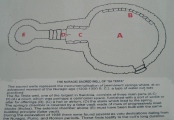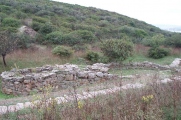<< Our Photo Pages >> Sa Testa Pozzo sacro - Holy Well or Sacred Spring in Italy in Sardinia (Sardegna)
Submitted by AlexHunger on Saturday, 25 March 2006 Page Views: 7008
Springs and Holy WellsSite Name: Sa Testa Pozzo sacro Alternative Name: Sa Testa Sacred wellCountry: Italy Region: Sardinia (Sardegna) Type: Holy Well or Sacred Spring
Nearest Town: Olbia Nearest Village: Olbia
Latitude: 40.934590N Longitude: 9.546020E
Condition:
| 5 | Perfect |
| 4 | Almost Perfect |
| 3 | Reasonable but with some damage |
| 2 | Ruined but still recognisable as an ancient site |
| 1 | Pretty much destroyed, possibly visible as crop marks |
| 0 | No data. |
| -1 | Completely destroyed |
| 5 | Superb |
| 4 | Good |
| 3 | Ordinary |
| 2 | Not Good |
| 1 | Awful |
| 0 | No data. |
| 5 | Can be driven to, probably with disabled access |
| 4 | Short walk on a footpath |
| 3 | Requiring a bit more of a walk |
| 2 | A long walk |
| 1 | In the middle of nowhere, a nightmare to find |
| 0 | No data. |
| 5 | co-ordinates taken by GPS or official recorded co-ordinates |
| 4 | co-ordinates scaled from a detailed map |
| 3 | co-ordinates scaled from a bad map |
| 2 | co-ordinates of the nearest village |
| 1 | co-ordinates of the nearest town |
| 0 | no data |
Internal Links:
External Links:
I have visited· I would like to visit
SolarMegalith visited on 13th Sep 2009 - their rating: Cond: 4 Amb: 5 Access: 4
Sacred nuragic well within structure facing west dating to Bronze age (1200-1000 BCE). There is a round structure in front with seats in the foundations. Between two hills with stream running towards sea. 33 Meters altitude. Votive objects found. A rectangular ditch of unknown origin has been built on East, North and West side.
Note: Exct GPS position from handheld GPS device.
You may be viewing yesterday's version of this page. To see the most up to date information please register for a free account.



Do not use the above information on other web sites or publications without permission of the contributor.
Click here to see more info for this site
Nearby sites
Click here to view sites on an interactive map of the areaKey: Red: member's photo, Blue: 3rd party photo, Yellow: other image, Green: no photo - please go there and take one, Grey: site destroyed
Download sites to:
KML (Google Earth)
GPX (GPS waypoints)
CSV (Garmin/Navman)
CSV (Excel)
To unlock full downloads you need to sign up as a Contributory Member. Otherwise downloads are limited to 50 sites.
Turn off the page maps and other distractions
Nearby sites listing. In the following links * = Image available
3.5km NW 305° Cabu Abbas Complesso Nuragico* Broch or Nuraghe
4.9km NW 321° Monte Conia Nuraghe Broch or Nuraghe
5.4km NW 325° Campu Majore Dolmen Burial Chamber or Dolmen
5.4km NW 307° Nuragadena Nuraghe Broch or Nuraghe
6.4km NW 306° Culatolzu Nuraghe Broch or Nuraghe
6.8km NW 308° Lattumbrosu Nuraghe Broch or Nuraghe
7.6km SSW 208° Lu Montigghju Longu Nuraghe Broch or Nuraghe
8.4km SW 218° Su Monte 'e S'Abe Tomba di Giganti* Chambered Tomb
9.0km W 264° Paulelada Nuraghe Broch or Nuraghe
9.6km NNW 338° Cugnana Pozzo Sacro* Holy Well or Sacred Spring
9.8km NE 47° Milis Pozzo Sacro* Holy Well or Sacred Spring
11.1km W 264° Caprolu Nuraghe Broch or Nuraghe
11.3km W 267° Labia Tomba di Giganti Chambered Tomb
11.8km SSW 210° Zappali Mannu Nuraghe Broch or Nuraghe
13.1km WSW 255° Lu Naracu Nuraghe* Broch or Nuraghe
13.2km W 273° Monti Pinu Muraglia Megalitica* Stone Fort or Dun
13.4km SW 233° Sa Prexone de Siana Nuraghe Broch or Nuraghe
15.2km NNW 345° Lu Naracacciu Nuraghe Broch or Nuraghe
15.8km NNW 341° Monti Canaglia Nuraghe Broch or Nuraghe
17.2km NW 323° Monti Aguisi Nuraghe Broch or Nuraghe
18.7km NNW 337° Baignoni Nuraghe Broch or Nuraghe
18.7km NW 323° Moru Tomba di Giganti* Chambered Tomb
18.7km NW 322° Albucciu Nuraghe* Broch or Nuraghe
19.7km NW 325° Malchittu Tempietto A* Ancient Temple
19.7km NW 325° Malchittu Tempietto B* Ancient Village or Settlement
View more nearby sites and additional images






 We would like to know more about this location. Please feel free to add a brief description and any relevant information in your own language.
We would like to know more about this location. Please feel free to add a brief description and any relevant information in your own language. Wir möchten mehr über diese Stätte erfahren. Bitte zögern Sie nicht, eine kurze Beschreibung und relevante Informationen in Deutsch hinzuzufügen.
Wir möchten mehr über diese Stätte erfahren. Bitte zögern Sie nicht, eine kurze Beschreibung und relevante Informationen in Deutsch hinzuzufügen. Nous aimerions en savoir encore un peu sur les lieux. S'il vous plaît n'hesitez pas à ajouter une courte description et tous les renseignements pertinents dans votre propre langue.
Nous aimerions en savoir encore un peu sur les lieux. S'il vous plaît n'hesitez pas à ajouter une courte description et tous les renseignements pertinents dans votre propre langue. Quisieramos informarnos un poco más de las lugares. No dude en añadir una breve descripción y otros datos relevantes en su propio idioma.
Quisieramos informarnos un poco más de las lugares. No dude en añadir una breve descripción y otros datos relevantes en su propio idioma.